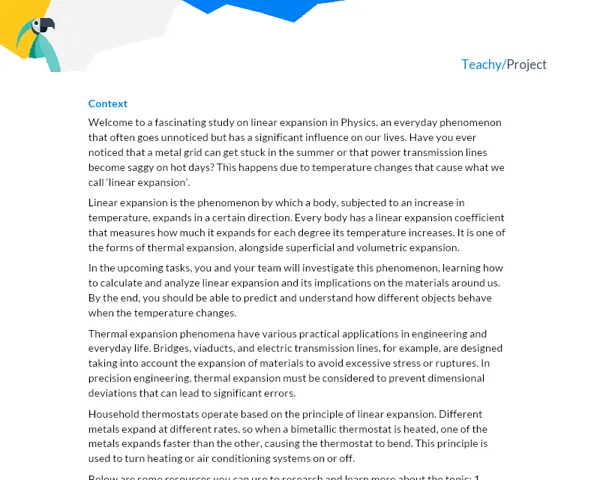Contextualization
Fourier's Law is a fundamental concept in physics that deals with heat conduction. Named after the French mathematician and physicist Jean-Baptiste Joseph Fourier, it describes the heat flow between different parts of a body or system and is essential in the study of thermal energy transfer.
Simply put, Fourier's Law states that the rate of heat transfer through a material is proportional to the temperature difference and the area through which the heat is transferred, and inversely proportional to the distance that the heat must travel. Applications of this law are far-reaching, touching on disciplines ranging from engineering and climatology to biology and medicine.
Theoretical Introduction
To delve deeper into Fourier's Law, it is important to understand the concepts of heat, temperature, and thermal conductivity.
Heat is a form of energy that is transferred between two systems or to a system from its surroundings due to a difference in temperature. Temperature is a measure of the average kinetic energy of the particles in a system. Thermal conductivity, on the other hand, is a property of a material that indicates its ability to conduct heat.
In Fourier's Law, these three concepts appear in the form of a mathematical equation that quantifies the rate of heat transfer. The precise formulation of this law can vary depending on the exact situation, but in its simplest form, it can be written as: Q = k * A * (dT/dx), where Q is the amount of heat transferred, k is the thermal conductivity, A is the area through which the heat is transferred, dT is the temperature difference, and dx is the distance of heat flow.
Importance and Applications
Fourier's Law plays a critical role in many fields of science and engineering. In mechanical engineering, it is used to design cooling and heating systems. In civil engineering, it is applied in building design to ensure thermal comfort. In medicine, it is used to understand heat flow in the human body, which is essential for procedures such as thermography.
Furthermore, Fourier's Law has significant implications for environmental issues. It is used to understand how heat is transferred in the atmosphere and the Earth, which is crucial for predicting climate change.
Practical Activity: "Metal Rod" Experiment
Project Aim
The aim of this project is for students to apply Fourier's Law by conducting an experiment that involves measuring the rate of heat transfer through different metal rods. This experiment will allow students to understand how different materials transfer heat at different rates, a key concept in Fourier's Law.
Project Outline
In this project, students will work in groups of 3 to 5. Each group will construct a "metal rod", an apparatus consisting of a set of rods made of different metals (e.g., copper, aluminum, iron) that are all heated at one end. The groups will measure the rate at which heat travels along each rod and compare the results.
The project will take approximately one month to complete, with an estimated 5-10 hours of work per student. This includes time for building the experimental apparatus, conducting the experiment, analyzing the results, and writing the report.
Materials Required
- Rods of different metals (copper, aluminum, iron)
- Heat source (e.g., an electric heating element)
- Thermometers or temperature sensors
- Protractor for measuring the area of the rods
- Ruler or measuring tape for measuring distance
- Stopwatch
Step-by-Step Guide to Carrying Out the Activity
-
Setting up the experimental apparatus:
- Students should set up the experimental apparatus with the heat source at one end of each metal rod.
- They should place thermometers or temperature sensors along each rod at regular intervals.
-
Conducting the experiment:
- Students should simultaneously start heating the rods.
- They should record the temperature at each sensor at regular time intervals (e.g., every minute) for a set period (e.g., 30 minutes).
-
Data analysis and conclusions:
- Students should create graphs of temperature versus time for each rod.
- Based on the data and graphs, they should compare the rate of heat propagation in each rod and relate it to the properties of each metal.
Project Deliverables
At the end of the project, each group must submit a written report. The report should be divided into four main sections: Introduction, Development, Conclusions, and Bibliography.
- Introduction: Should include the context of the project, the importance of Fourier's Law, and the aim of the experiment.
- Development: Students should detail how they set up the experiment, discuss the theory that supports their methods (such as Fourier's Law), explain the experimental procedure, and present the results obtained.
- Conclusions: Should summarize the results, reflecting on what they indicate about Fourier's Law and the properties of the different metals used in the experiment. Students should also reflect on the skills they acquired during the project, both technical and socio-emotional.
- Bibliography: Students should list all the sources of information they used during the project.
By the end of the project, students will not only have solidified their understanding of Fourier's Law and heat transfer, but they will also have developed important skills that will be useful in their future academic and professional careers.


